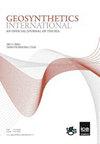Pullout capacity at the bamboo reinforcement-compacted earth interface
IF 2.8
2区 工程技术
Q2 ENGINEERING, GEOLOGICAL
引用次数: 0
Abstract
Compacted earth materials are still popularly used to construct wall structures in rural areas. To address the drawbacks of poor ductility and low shear resistance in compacted earth walls, bamboo, with excellent tensile properties, is introduced as a reinforcement material. Pullout tests on bamboo-reinforced compacted earth were conducted in this study, in which the effects of four parameters of normal stress, bamboo reinforcement form (without node, with node, and with curved anchor head), bamboo reinforcement width, and embedment length were investigated. Results demonstrated that the presence of chemical bonding force, frictional resistance, and end resistance at the interface between bamboo reinforcement and compacted earth could contribute to the mobilized pullout capacity. The parameter impact on pullout resistance can be ranked as follows: embedment length > bamboo reinforcement width > normal stress > bamboo reinforcement structure. Based on the Mohr strength theory, a model for estimating the ultimate tensile capacity of bamboo-reinforced compacted earth was derived. The pullout capacities obtained from theoretical calculations and experimental measurements differed from 0.73% to 14.60%, mostly failing below 10%. The proposed calculation model enabled the estimation of load-bearing capacity at the bamboo reinforcement-compacted earth interface, providing valuable guidance for wall design.竹筋与夯实土界面的拉拔能力
农村地区仍然普遍使用夯土材料来建造墙体结构。针对夯土墙延性差、抗剪性低的缺点,人们引入了抗拉性能优异的竹子作为加固材料。本研究对竹子加固的夯实土墙进行了拉拔试验,研究了法向应力、竹子加固形式(无节点、有节点和弧形锚头)、竹子加固宽度和嵌入长度四个参数的影响。结果表明,竹筋与夯实土界面上存在的化学粘结力、摩擦阻力和端面阻力会对动员抗拔能力产生影响。参数对抗拔能力的影响可按以下顺序排列:预埋长度 > 竹筋宽度 > 法向应力 > 竹筋结构。根据莫尔强度理论,推导出了一个估算竹加固夯实土极限抗拉能力的模型。理论计算和实验测量得出的拉伸能力从 0.73% 到 14.60% 不等,大部分低于 10%。所提出的计算模型能够估算竹筋夯土界面的承载能力,为墙体设计提供了宝贵的指导。
本文章由计算机程序翻译,如有差异,请以英文原文为准。
求助全文
约1分钟内获得全文
求助全文
来源期刊

Geosynthetics International
ENGINEERING, GEOLOGICAL-GEOSCIENCES, MULTIDISCIPLINARY
CiteScore
6.90
自引率
20.00%
发文量
91
审稿时长
>12 weeks
期刊介绍:
An online only, rapid publication journal, Geosynthetics International – an official journal of the International Geosynthetics Society (IGS) – publishes the best information on current geosynthetics technology in research, design innovation, new materials and construction practice.
Topics covered
The whole of geosynthetic materials (including natural fibre products) such as research, behaviour, performance analysis, testing, design, construction methods, case histories and field experience. Geosynthetics International is received by all members of the IGS as part of their membership, and is published in e-only format six times a year.
文献相关原料
| 公司名称 | 产品信息 | 采购帮参考价格 |
|---|
 求助内容:
求助内容: 应助结果提醒方式:
应助结果提醒方式:


